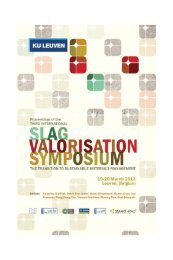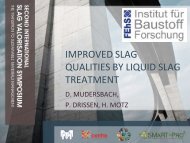International Slag Valorisation SymposiumLeuven6-7/4/2009 - Third ...
International Slag Valorisation SymposiumLeuven6-7/4/2009 - Third ...
International Slag Valorisation SymposiumLeuven6-7/4/2009 - Third ...
You also want an ePaper? Increase the reach of your titles
YUMPU automatically turns print PDFs into web optimized ePapers that Google loves.
obtained from pure CO2/N2 gas mixtures in the laboratory. Direct in-line mineral<br />
carbonation thus seems to have potential.<br />
Related to the industrial application of in-line ash carbonation, the concept of leading<br />
the stack gas in counter-current over a layer of bottom ash on a moving belt has been<br />
investigated with respect to the acceptable thickness of the bottom ash layer. 13) Figure 2<br />
gives the pH results over time for a 10 cm thick layer of bottom ash of which the top<br />
surface was contacted with 10% CO 2 at 50°C. After one week almost the complete<br />
sample had reached pH 8.5-9 and was considered to be carbonated. A simple model<br />
predicts the experimental results reasonably well. Further process improvement is<br />
obviously necessary before industrial feasibility can be considered.<br />
depth [cm]<br />
0<br />
1<br />
2<br />
3<br />
4<br />
5<br />
6<br />
7<br />
8<br />
9<br />
1 0<br />
0<br />
1<br />
2<br />
3<br />
4<br />
5<br />
6<br />
7<br />
8<br />
9<br />
10<br />
8 ,08,5 9 ,09 ,51 0 ,01 10, 1 1, 1 , 2 12 , 1, 3 ,<br />
5 05<br />
0 5 0<br />
start<br />
1 day<br />
2 days<br />
1 week<br />
8 9 1 0 11 12 1 3<br />
pH<br />
1 st <strong>International</strong> <strong>Slag</strong> <strong>Valorisation</strong> Symposium│Leuven│6-7/4/<strong>2009</strong><br />
0<br />
1<br />
2<br />
3<br />
4<br />
5<br />
6<br />
7<br />
8<br />
9<br />
10<br />
8 9 10 11 12 13<br />
pH<br />
Figure 2: Experimental (left) and modelling (right) results of accelerated carbonation of<br />
a 10 cm bottom ask layer over time.<br />
The reaction term was studied using a carbonation experimental set-up that was<br />
developed at the department of Civil Engineering. In this set-up, lime paste is subjected<br />
to high CO2 concentration to simulate an accelerated carbonation process. This<br />
experimental study is based on measuring the CO2 concentration during the carbonation<br />
reaction. Net CO2 uptake by calcium hydroxide is determined and based on this the<br />
reaction rate is calculated. Using this set-up, the carbonation reaction was studied at<br />
ambient temperatures with various lime binders 7) and with hydraulic binders 24) at<br />
various CO2 gas concentrations (20%, 50% and 100%). This study has verified the lime<br />
mortar carbonation model and has improved understanding of the factors influencing<br />
the carbonation reaction rate in a porous system. The reaction rate is not proportional to<br />
the CO2 gas concentration but is rather influenced by the material properties of lime as<br />
the specific surface area. In the case of incinerator bottom ash, there is also no<br />
advantage in increasing the CO2 gas concentration, which again illustrates that a 10%<br />
CO2 stack gas is very suitable for mineral carbonation processes. 8,13)<br />
Further insights have been gained on the carbonation reaction mechanism and on the<br />
reaction rate with recent research using this carbonation experimental set-up coupled<br />
depth [cm]<br />
1 week<br />
2 days<br />
1 day<br />
start<br />
30







